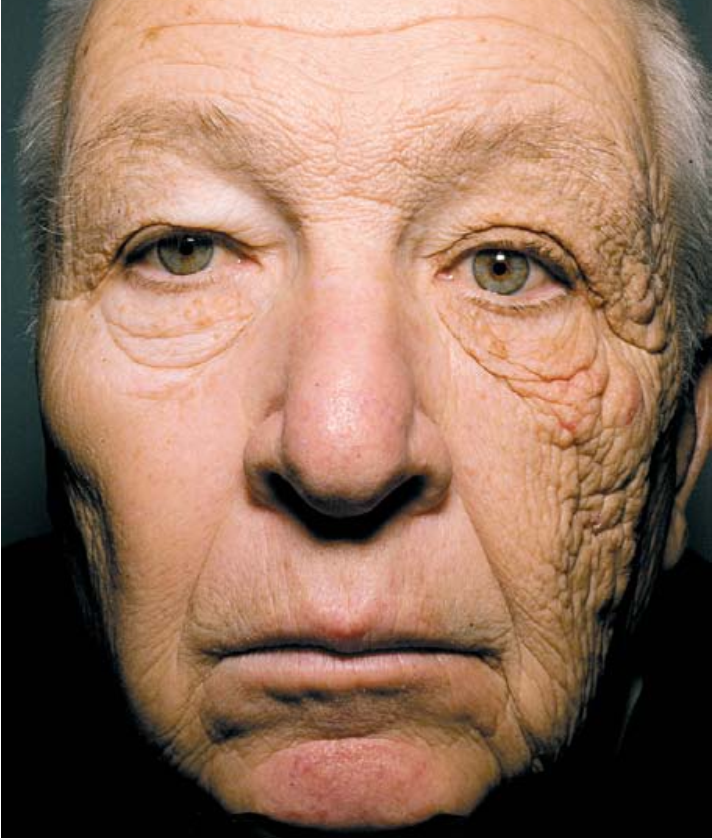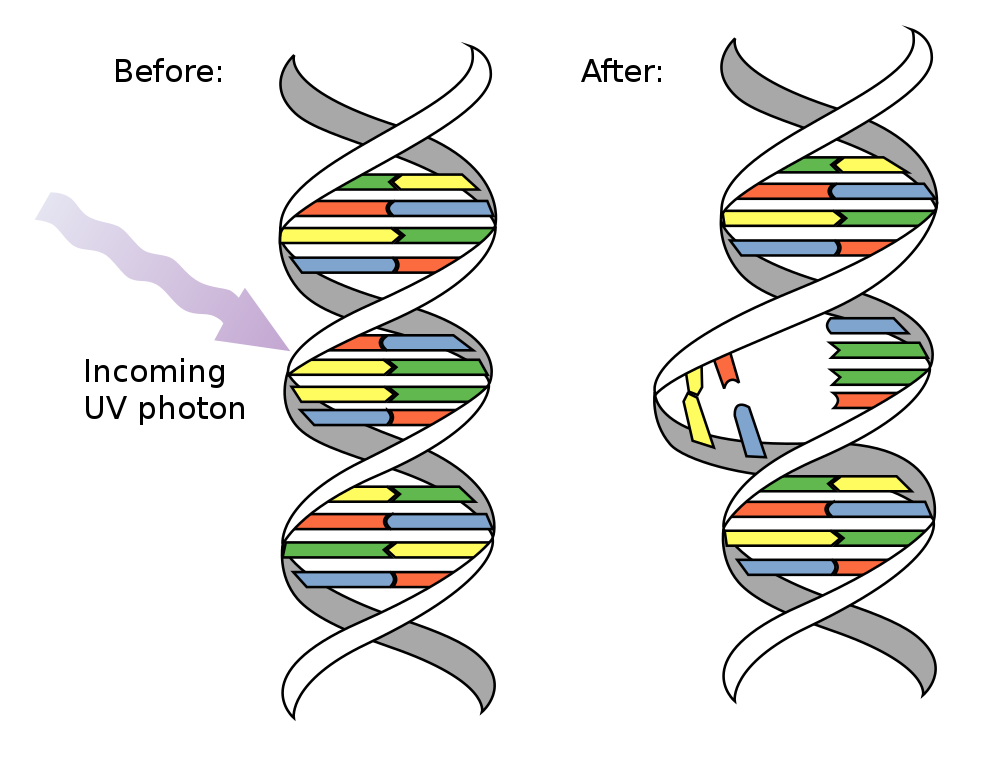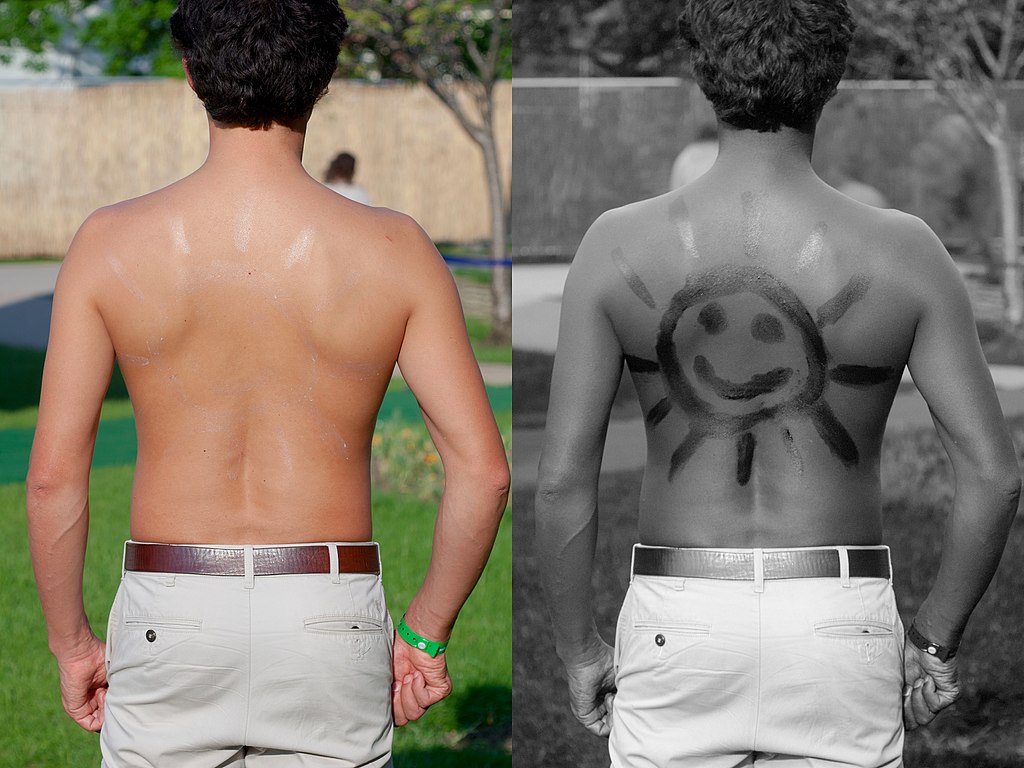
Pictured is a truck driver who has driven trucks across the United States for 28 years. The glass was closed and the air conditioner was running. But the ultraviolet of the UVA spectrum perfectly penetrates it and causes skin damage and photoaging. A scientific publication on his occasion can be viewed here . Ultraviolet light triggers a bunch of unpleasant reactions in the body and tears DNA into pieces. This phenomenon is called photolysis .
Tanning is cute, but it's always a pathology and a way to protect yourself from damage. There used to be an excellent, in my opinion, fashion for pallor and sun umbrellas. Now everyone is diligently sunbathing on the beach and in the solarium. Therefore, if you do not want to look like an elderly farmer from rice fields at the age of 30, you must definitely protect your skin with special SPF formulations. The Sun Protection Factor on the label shows how long you can stay in the sun with this product. For example, if SPF 50+, and you burn out to the state of a tomato in ten minutes, then with it you can hold out for 10 * 50 minutes, that is, almost eight hours.
Although our lab has been developing skin care products for a long time, it was interesting for us to work with reflective nanoparticles to create an SPF product. Now I'll tell you more about them. And also about the bald mice on which all this is tested.
Hurray, the quarantine is lifted
It seems like the official ratings began to look very nice, and the
But if the residents of Krasnodar Territory, Simferopol and other hot regions have learned the rules of survival in a southern climate for many years, then guests from the northern regions traditionally suffer. A classic picture - crimson-crimson bodies of uniform roasting, lying at noon on the beach. The vacation is short, you need to tan to the maximum. Then it all ends with attempts to smear with strange substances like sour cream, kefir or some other kumis. And also a reticulated python-style molt a few days later.
Features of ultraviolet radiation
What is the insidiousness of ultraviolet radiation? Let's take two people and begin to gently fry them with radiation at different wavelengths.
Let's direct a powerful infrared searchlight at the first person. At first he will feel warm, and then he will begin to swear and try to leave, because it burns. Infrared radiation is detected by our receptors immediately and has fast-acting effects. Have you seen people who have been in a dry sauna for a long time? This is approximately the same erythema (redness) will be when exposed to infrared rays. It occurs quickly and passes quickly within 30-60 minutes. If you fry for a long time and regularly, which is typical, for example, for summer residents, then an ugly brown spotted pigmentation will appear on the skin.
Let's direct an ultraviolet source to the second person. If its power is not too great, then at best it will feel a slight tingling sensation and irritation. This is often the case in low-power tanning salons. No erythema, no visible changes. Everything seems to be good. The most unpleasant begins after 6-12 hours, when the skin, in response to hidden damage, begins to emit the inflammatory mediator histamine. A rather painful ultraviolet erythema appears. The skin is red, swollen and painful for three to five days. Then it turns pale and either simply darkens due to the synthesis of melanin by melanocytes, or begins to peel off and flake off as a result of significant damage.
A little bit of physics and photochemistry
Photons with wavelengths near ultraviolet light already carry enough energy to initiate chemical reactions. Actually, that is why they belong to ionizing radiation. The shorter the wavelength, the more energy the photon carries, in full accordance with the formula "E = hv".
The mechanism of injury is associated with the formation of free radicals and the activation of chemical reactions by photons. Such a photon, arriving in a biological fluid, is absorbed and generates a molecule of hydrogen peroxide or free radicals.

Ultraviolet mutagenesis
A photon can also target a valuable protein molecule or DNA strand, causing damage. If you're very unlucky, you can end up with a type of skin cancer, like melanoma.
In principle, the sudden formation of hydrogen peroxide and free radicals is a common problem for our body. To do this, we have a bunch of defense mechanisms like an enzyme with the complex name superoxide dismutase. And also antioxidant vitamins like tocopherol and ascorbic acid, which take a hit and protect membranes. Difficulties begin when the radiation power exceeds the protective capabilities of the body.
Doses that do not cause visible damage are called suberythemal, that is, do not provoke redness. Ideally, you shouldn't blush after visiting the beach. Then we can talk about the beneficial effects of ultraviolet radiation, such as the synthesis of vitamin D and the immunostimulating effect.
There are several options for classifying parts of the spectrum in the ultraviolet zone. If you do not take into account extreme ultraviolet (EUV), then three ranges are relevant for us:
- UVA. Wavelength 400-315 nm. The softest part of the ultraviolet. The energy is minimal, it passes the atmosphere without problems.
- UVB. Wavelength 315-280 nm. For the most part, it is absorbed by the ozone layer of the atmosphere and almost does not reach the surface.
- UVC. Wavelength 280-100 nm. Hard ultraviolet light, completely absorbed by the atmosphere. Found only in artificial sources like quartz lamps.
UVC, very harsh, not found outdoors. It is used to kill microbiological animals in laboratories, hospitals and other premises. It causes severe burns, but superficial, since it is almost completely absorbed by the epidermis and does not penetrate deeply. A colleague in practice had a case when a patient in a hospital went to the toilet at night and found a wonderful blue night light. I decided it was pretty convenient and left it on. In the morning everyone was quickly sent to the burn department. Everything that stuck out from under the blanket was bright red. Everything worked out, but since then the power button has been closed with an additional cover from the especially curious.
In terms of day-to-day skin damage, we are more interested in the UVA and UVB range. UVB makes you a crimson tomato at once simple and straightforward. About 15% of the radiation reaches the germ layer - the basal cell layer. UVA is mild, almost does not cause erythema. But it is cunning in that it passes well through window glass and penetrates deep into the skin. Up to 68% of radiation passes through the germ layer and is absorbed by the dermis.
That is why we are interested in UVB from the point of view of acute skin injuries, and UVA - from the point of view of chronic, leading to damage to fibroblasts and the growth zone of the skin. The result of such exposure is premature photoaging. This is very noticeable when looking at the skin of people who work outdoors most of the time.
Protecting your skin
Thomas Leveritt, an English artist, was able to visually demonstrate what happens to us due to ultraviolet rays. He used extremely expensive lenses that were transparent to UV light and a special camera. The video clearly shows the difference in the structure of the skin of children and adults, whose skin bears traces of numerous microdamages from solar radiation.

Skh bald mouse: HR-1. You also need to cover with sunscreen
. We have several strategies for protection. We can reflect ultraviolet light, we can absorb it and further protect the skin with antioxidants. The naked mouse is a classic model mechanism for testing such defense systems. Let's say one of the studiesshowed that alpha-tocopherol and ascorbic acid reduced the risks of skin pathological changes and tumor formation in mice.
We did a lot of research, after which our team of experienced chemists was able to prepare the optimal protective formula. The result is the drug " Multiprotector SPF50 + oil free ". Now I'll tell you what we added there and why there are so many components at the same time.
The first component is titanium dioxide nanoparticles. They are white. No, not even that, they are very white. Actually, if you buy paint for the ceiling, do not take it with zinc oxide - it is grayish. The whitest paints with titanium dioxide. It also reflects and scatters ultraviolet light. At the same time, it is not so hot with it, since it also reflects visible and infrared radiation. Unfortunately, few people want to look like a mime with a snow-white face. Therefore, its quantity in the composition is strictly limited.

An example of UV absorption by a protective cream
Next comes the components that absorb UV light, preventing it from reaching the skin. Here we have already picked up a complex composition that is rarely used in cheap protective creams:
- Ethylhexyl methoxycinnamate : organic UVB filter with a high safety profile, non-comedogenic.
- : -, UVB-.
- : , UVA- .
- Tinosorb M: - , . — UVA UVB, , (HEV).
- : UVB-.
Why are there so many components? The problem is that you can't just go and throw in more stuff. Side effect of irritation or comedogenic formation may occur. With a properly selected formula, you will simultaneously receive a wide overlap of the entire spectrum and the absence of a negative effect of the components.
We also added fucogel to the composition . It is an interesting biosaccharide resin. We use it to feed good bacteria and deeply moisturize the skin. As a result, we get a normal healthy microflora and the restoration of the protective barriers of the skin.
Time to sea
The sea is great. Just remember that tanning is basically an attempt by the body to defend itself. It is beautiful, but in terms of health it is healthier to be white. Moreover, the same vitamin D can be safely obtained in the form of capsules, and not creepy fish oil in a bottle.
If you are planning to sunbathe, always limit your time at the beach. Try not to go out in the sun from 10 am to 4 pm so as not to expose your skin to unnecessary danger. Suberythemal doses where the skin is not red is the best option. This tan may be less intense, but will last longer. When you get home, wash in the shower so as not to leave the protective cream. Then apply some moisturizer. You can use our " Moisturizing Gel + ". It is relatively inexpensive and also with fucogel for microflora.
If you feel that your end is near, and your skin has a delicate purple hue, then I would not advise smearing sour cream or even more sunflower oil. In case of burns, any fats are contraindicated. Better cold compresses and hydrophilic gels with light textures. If you find something like our Intensive Regeneration (here is a post on Habré about development), it will be absolutely perfect. But you can't call it budget any more - the production is complex and requires expensive and especially pure components.
A moment of shameless advertising. We made Habr's readers a 10% discount on Ozone for all our cosmetics - the promo code HABR10. And yes, I really dreamed of saying something like that a couple of years ago, when the problem was to find something in our laboratory besides Blefarogel other than in production. Well, look into ourtelegram channel (@geltek_cosmetics). There is about the chronicles of our cozy laboratory.